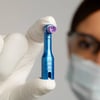Each week, Young Innovations hosts a free CE course for dental hygienists, covering a variety of topics taught by clinicians from all walks of the profession. Whether you missed the live webinar or were able to attend, these course notes are intended to support clinicians with quick, digestible takeaways from our CE courses.
Often, patients don't understand that biofilm can be the initial cause of demineralization, caries and periodontal disease. With proper homecare strategies, patients can easily add biofilm management to their daily regimen. Biofilm-focused care is essential in providing longevity in dentition and optimal care for the overall health of our patients.
Here are a few quick points about biofilm, and how you and your patients can take steps to keep it under control.
What is biofilm?
Biofilm is made up of over 500 microorganisms and plays a significant role in gingivitis, periodontitis and dental caries.
How is biofilm identified?
Use of a disclosing agent allows for complete and thorough biofilm removal and allows for optimal patient education on biofilm removal at home.
How is biofilm removed?
Clinically, biofilm is often removed via selection polishing, air polishing or air flow.
What’s the best paste grit to use?
When using prophy paste, select a grit based on the type and amount of stain present. You can also target tougher stains with a heavier grit, and use a lighter grit on other surfaces.
Are paste ingredients important?
Using prophy pastes with xylitol or baking soda can help to neutralize the pH.
What about air polishing?
Air polishing powders have come a long way and now include powders that are less abrasive, less messy or cause less tissue damage or can be used subgingivally with the certain systems.
How can you remove biofilm more safely?
Before patient care, pre-procedural rinses can help reduce microorganisms from becoming aerosolized.
For other useful Course Notes recaps, visit the Continuing Education section of our blog.




Submit a Comment